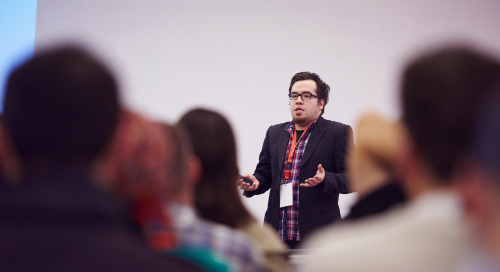how-to-make-social-media-a-powerful-member-engagement-tool
July 25, 2017
From developing a consistent tone of voice to determining how to measure your success, social media offers a challenging yet powerful opportunity to build a community for your members that stretches around the world. We asked a few of our partner societies about how they’re using social media to engage their members.
American Headache Society
Matthew S. Robbins, MD, FAAN, FAHS; Chair, Electronic Media Committee AHS
The purpose of social media for us is to extend the reach of our society members to patients and the public. It’s an important information channel today; one I don’t think we can do without.
We use Twitter chats to help our members interact with the other groups we serve. In the past we’ve partnered with patient advocacy organizations in chats so our researchers help answer patient questions. By participating with other organizations, we can widen our audience and enable our members to have real impact on patient lives.
The impact of social media is hard to measure. There’s a randomness to it that makes it very unpredictable. But for our organization, measuring its success is critical for us to determine what’s most successful and also to validate the impact of social media for AHS. As part of the past couple of AHS meetings, we’ve presented data on our social media use with detailed metrics. One year, we analyzed the impact of our social media over several consecutive conferences. We identified a significant increase in #migraine tweets during the conference from Twitter users not in attendance, suggesting that conference tweets about #migraine influenced the discussion outside of the conference itself.
Showcasing the data has led to new investments for our society: we have now enlisted professional digital marketing help to handle our social media since the society leadership identified it as a major priority worthy of investment.
See more @ahsheadache.
European Molecular Biology Organization
Tillmann Kiessling, Head of Communications
EMBO uses social media as additional communications channels to communicate news and achievements from the organization, its various communities of life scientists, and from the EMBO Press journals. More importantly, EMBO uses the capacity of social media to engage on distinct, but integrated channels with specific and specialized audiences in order to interact with them on topics of their interest, e.g. with EMBO Fellows (postdoctoral researchers) on Facebook; with EMBO Young Investigators (principal investigators supported by EMBO) on Twitter; with scientists interested in
advancements in scientific publishing via a Twitter handle run by the EMBO Head of Scientific Publishing; and to promote the EMBO Press journals via Twitter (e.g. the EMBO Journal). Applicants for open positions at EMBO are increasingly coming to EMBO triggered by information shared on social media.
A spontaneous project which has gained surprisingly high engagement through social media and which resulted in international media coverage was the Science Solidarity List, initiated by EMBO on its webpage. Soon after its launch, it was referred to with the hashtag #ScienceSolidarity and became viral, impressively demonstrating the life science community's solidarity for their peers affected
by a temporary travel ban imposed by the Trump administration earlier this year on scientists from six Muslim-majority countries.
See more @EMBOComm.
British Society for Eighteenth-Century Studies
Dr Danielle Thom, Communications Officer
We used to have several different Twitter accounts for different purposes or audiences, like our postgrad activities and for our online reviews ‘Criticks.’ This year, I merged these with the main account to avoid confusion and create a more coherent online identity; now the BSECS officers responsible for those areas tweet via the main account.
My aim is to make the Twitter account informal and engaging, and provide a fairly comprehensive overview of what’s going on in the wider field of 18th century studies. We have an email newsletter which goes out to our members every couple of months, which contains BSECS updates and selected job vacancies, calls for papers and reviews. However, the Twitter account is open to all and I try to make it as interdisciplinary and comprehensive as possible. Occasionally, I will retweet things from other scholarly societies, but they retweet us on other occasions. In that sense, it’s not a competitive forum, but a collaborative one.
On Facebook, much of our content is follower-generated. I review and approve submissions from people wanting to post about books, calls for papers, seminars and other activities. In this way the society’s social media becomes a platform for our members to discuss what most matters to them.
See more @BSECS.
The Obesity Society
Tanesia Dwight, Manager of Marketing, Membership & Partnerships
The Obesity Society’s social media strategy is two-fold. The first objective is to provide the public with informative content on all aspects of obesity research, whether from our journal Obesity or from members. The second objective is to make our posts fun and engaging. TOS is a scientific organization, but it’s also a community where our members can network, find collaborators and share ideas. A couple of social media examples are Twitter polls and society tips. On Twitter Poll Tuesdays, we ask fun questions such as our audience’s favorite TV nurse or medical drama. On TOS Tip Thursdays, we highlight past society press releases as our version of throwback. These initiatives have been more successful than we anticipated because they integrate so easily into the feed and have significantly boosted our audience engagement.
In addition to our social strategy, we’ve increased member engagement with a society blog. Our blog provides the platform through which early career members interview leaders in the field of obesity. We’re delighted to be able to facilitate these interactions between our younger members and veteran professionals. We also include features of the TOS President and Executive Director to lend further credibility while incentivizing our members to contribute.
See more @ObesitySociety.
No matter the field, one thread running through each of these conversations was the willingness to use social media to experiment. Some things work—perhaps better than expected—and others will be less successful, but either way social media is a place where you can pilot new engagement strategies. Is your organization trying anything new? Let us know in the comments below.
Image credit: Cultura RF/Getty Images







